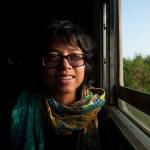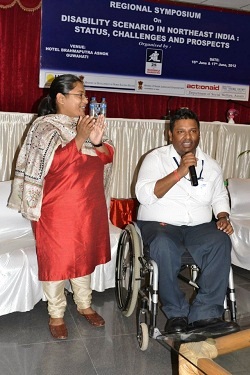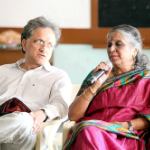Assamese author Hem Barua wrote Mekong Noi Dekhilu (Saw the River Mekong) in 1967. His travelogue created a very romantic picture of the river in my then young mind. My mother would often casually refer to the book in her conversations creating a special connection with a river we never saw, but only heard and read about. Twenty five years after reading about it, I finally got to see the river.
In this part of the world, Mekong river is the border between Thailand and Laos. In Vientiane, sitting by the river, you can see the houses and Wats or temples in Thailand looking very similar to the houses and Wats in this side.
My friend Anna's dad PJ has a beautiful house by the river. Through the windows of PJ's house, I would stare at the houses on the other side of the river and imagine those stories I read about Laos in the post-independent 70's - of people trying to swim away to Thailand.
The world knows about the famous Vietnam War. Mostly through reactionary American movies like Rambo that flooded post-war Hollywood.
What the world does not know is that in the war between America and Vietnam, Laos turned out to be the most heavily bombed country in the world. Roughly 270 million cluster bombs were dropped in Laos1. And that, in a country whose current population is around 6.5 million and in a war that was not even theirs!
When I try to wrack my head over these figures and try to understand why, I come with zero reasons. Call it my bad math skills or could be simply, bad politics.
During those confusing times, the relationship of Laos with its neighbours deteriorated steadily. Thailand, Vietnam, China - one by one each turned hostile against it for some reason or the other. After a series of wars, freedom struggle and false promises by the colonial masters, the Laos Peoples' Democratic Republic was finally formed in 1975.
In the newly formed communist country of Laos, things were not easy.
The country had just seen more than three million bombs dropped during the Vietnam War. Post war, Laos People's Democratic Republic came down heavy upon its people following their Chinese elder cousins for social reforms. This meant people could no longer listen to radio or want to have fun.
The only entertainment they could enjoy, was to find pleasure in community work digging irrigation cannels or cleaning sewage lines and scratch their artistic itching with badly rhymed songs of revolution. Naturally, many wanted to swim across to Thailand. There was pop music and romantic cinema on the other side.
Thailand however was not so romantic about these desperate dare devil stunts like swimming across. You were lucky if you got let in by the Thais. Else, they would send you back home, or shoot you dead. You could be sent back and be shot dead by the Laos soldiers too.
Since the late 80's however, Laos' relationship with its neighbours has improved. Respecting free market rituals, Thai and Chinese capital has extended its arm full of grease to the Laotian palm. It is a wonder how financial interests can make people in power forget bitter history and design mutually beneficial presents.
The improved Thai-Lao relationship has led to the building of the Thai-Lao friendship bridge on the Mekong river between Nong Khai in Thailand and Vientiane in Lao. Talking about borders, it is very interesting how, when rivers become borders, the bridges create no-man's crossover spaces.
The border posts at this friendship spot are on the respective sides of the river. Once you have passed through immigration formalities on one side, you are not in the next country till you cross the river and register yourself on the other side.
For those moments that you are on the bridge in this case a 1.7 km long railway and road bridge), you actually do not exist in the legal eyes of the world! As a citizen of a modern nation state, you know that the proof of your existence is not in the fact that you can eat pudding, but that you are registered. If you have registered out of one country and have not registered into any other, well...
A Zen like sensation of not-being struck me when I crossed over the Nong Khai border into the friendship bridge. I wondered if I had any identity!
Thankfully, shuttle buses that ply every five minutes pick you up from one end of the bridge and drop you off at the other. So this feeling of no-existential-identity lasted only about 15 minutes.
At the other end of the bridge, I get directed towards the line that says 'Border Pass' for locals instead of the one that says 'Passports' for foreigners. I feel instantly at home! My identity crisis dissolves for the moment.
At PJ's house, I spend my first few moments looking at the river, slipping into the not-so-spiritual habit of comparing. Brahmaputra is much wider, I think. As if I somehow had a hand in making Brahmaputra a wider river.
PJ is a treasure trove of knowledge of rivers, as he studies rivers. He has been studying the Mekong for some years now. Obviously, we get talking. He also has an impressive collection of textile from various part of the world.
So our conversation moves from rivers to textiles. And tribes. He shows me books and pictures of Lao Tueng, Mhong, Dao, Sang, Mong, Lao-Tai and other tribes and tribal groups. They look like people back home in Assam - I compare again.
The dexterous Lao women have been making textiles from Lao famous since history. They use organic materials such as hemp and silk, and organic dyes to weave colourful stories of their lives, their history, and their culture. They use a host of techniques, equipment and tie-and-dye, batik, ikkat, threading, weaving applique and embroidery, are some of their specialties. Their motifs symbolise their ethnic identity, culture, mythology, their connections with nature and spirits. Their textiles are used for clothing, necessary in ceremonies and for expression of love and respect.
I went to visit Lao Textile, a company started by Carol Cassidy an American textile designer and engaging local weavers in producing world class silk and designs. Their silk is sent to Europe, America and other parts of the world and appreciated by the rich and the famous. My friend Anna, a textile designer who has worked with Lao Textile, insisted I visit them when in Vientiane.
I am once again kindly driven to Lao Textile and dumped ceremoniously on a man named Dawit. Dawit is Carol Cassidy's husband and is partner in Lao Textile.
Dawit shows me around, introduces me to all the weavers as Anna's friend. He informs me they started the business in 1989 and have managed to retain most of the workers they started with. He talks about how hard working the Lao women are and how useless the men.
He also says that the women tell him they have been able to find an identity and a place within their families and societies because of the work they do. In the beginning, it was very difficult to find weavers to work full time as traditionally women would weave only when they had time from doing other chores. Although exceptionally skilled, that weaving can be the main work and a source of income took some convincing.
He points out to Simone and says - 'look at Simone. She did not even want to come here. But now she is the head weaver and looks after the designs and work completely.' Simone gives a shy smile and gets busy.
Simone comes from a rural family where she learnt to weave from her mother. Traditionally, in the communities where weaving was a practice, women did it between other jobs. It was never a full time occupation and was not considered to be an income earning activity.
When Carol approached Simone, she and her family found it hard to believe that weaving could be a full time job. Nor could they believe that their produce would have a market outside. Simone's is not the only such story.
Most weavers, who are engaged in the thriving weaving industry in Laos, have the similar stories to share. Today, many like Simone work in Vientiane and have moved forward from weaving to designing and production. Many do it at home in their convenient time still. But they all earn money from it.
The very talkative Phone (pronounced Pon) who works in the administration of Lao Textiles, tells me she does not have the patience to weave. She buys the clothes that are traditionally required during rituals. They have special clothes for weddings, funerals, spiritual ceremonies and other such occasions. They also have a `love handkerchief' that a girl would weave for the boy she likes! I instantly remembered the Assamese gamocha (a type of traditional towel).
Like Carol Cassidy, many other designer-entrepreneurs set up weaving factories and galleries in Vientiane. They lent new ideas to the skills of the Lao women and together established a niche for the textiles of Laos. The weaving industry is integral to Laos' economy and empowerment of its women.
Weaving enterprise has been supported by the government of Laos from the start. When LPDR opened up market in the late 80's, they declared that women would be equal partners in building Laos' economy. They spoke about expanding women's role from the domestic to the productive economic activity.
Today, there are numerous organisations that support women's groups with micro-finance to business credits like Oak Pop Tok and IFAD. Along with income, weaving has earned women a position in society as a bread earner and has brought in greater mobility for them.
I get taken around in their shop/display area and am excited by the similarity I see between Assamese Pat silk designs and some of their work.
Dawit says - 'Oh you are from Assam? Yes, we have had some work done with a group in Nagaland. The techniques are similar but the Lao designs are much more intricate.' He informs me they wanted to tie up with groups in the North-East, but it did not work out. I wonder why.
Why is it that despite having similar skills, varied techniques and many numbers of skilled weavers, there is still not something called a weaving industry in the North-East?
Innovation and investment or the lack of it, comes to my mind as answers. True, there are hundreds of women's groups which are weaving and producing in the North-East, but their designs are same and old. One only needs to visit any Expo, Bohagi mela (a fair during a festival), trade fair etc twice to confirm this. Most weaving is still producing traditional attires for women like Mekhela-Sador and puan.
In terms of investment there are hardly any planned business endeavours. Self-help groups, receiving small credits, get minimum support in procurement and marketing of their products. There are no galleries showcasing their work except for the very boring and bureaucratic government emporiums. There is no respectable size financial investment. Will someone from North Eastern Development Finance Corporation Limited (NEDFI), International Fund for Agricultural Development (IFAD), Textile ministry please take note and up their game?
In this area, Fabric Plus, an organization deserves credit. It has been designing and producing world class dress and home decor materials using local weavers and materials. Fashion and upholstery designers and producers from all over the world place orders with Fabric Plus. Organisations and individuals willing to get involved can get tips from them too. My friend Anna can be of help too.
Only hope weaving as an enterprise puts North-East India on the international map!
Find us on facebook: facebook.com/TheThumbPrintMag







































